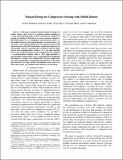Mission Design for Compressive Sensing with Mobile Robots
Author(s)
Hummel, Robert; Poduri, Sameera; Hover, Franz S.; Mitra, Urbashi; Sukhatme, Guarav
DownloadHover_Mission design.pdf (230.8Kb)
OPEN_ACCESS_POLICY
Open Access Policy
Creative Commons Attribution-Noncommercial-Share Alike
Terms of use
Metadata
Show full item recordAbstract
This paper considers mission design strategies for mobile robots whose task is to perform spatial sampling of a static environmental field, in the framework of compressive sensing. According to this theory, we can reconstruct compressible fields using O(log n) nonadaptive measurements (where n is the number of sites of the spatial domain), in a basis that is "in coherent" to the representation basis [1]; random uncorrelated measurements satisfy this incoherence requirement. Because an autonomous vehicle is kinematically constrained and has finite energy and communication resources, it is an open question how to best design missions for CS reconstruction. We compare a two-dimensional random walk, a TSP approximation to pass through random points, and a randomized boustrophedon (lawnmower) strategy. Not unexpectedly, all three approaches can yield comparable reconstruction performance if the planning horizons are long enough; if planning occurs only over short time scales, the random walk will have an advantage.
Date issued
2011-05Department
Massachusetts Institute of Technology. Department of Mechanical EngineeringJournal
IEEE International Conference on Robotics and Automation (ICRA), 2011
Publisher
Institute of Electrical and Electronics Engineers (IEEE)
Citation
Hummel, Robert, Sameera Poduri, Franz Hover, Urbashi Mitra, and Guarav Sukhatme. Mission Design for Compressive Sensing with Mobile Robots. In Pp. 2362–2367. 2011, IEEE.
Version: Author's final manuscript
ISBN
978-1-61284-386-5
ISSN
1050-4729